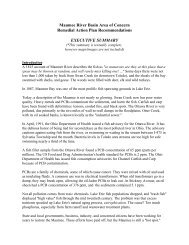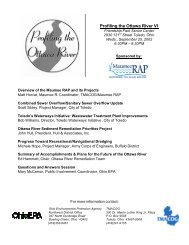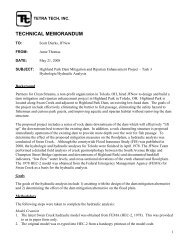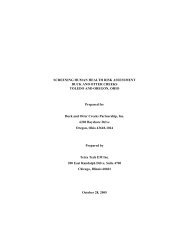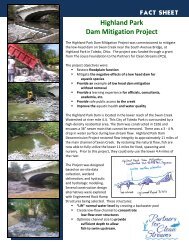Complete report - Partners for Clean Streams
Complete report - Partners for Clean Streams
Complete report - Partners for Clean Streams
Create successful ePaper yourself
Turn your PDF publications into a flip-book with our unique Google optimized e-Paper software.
Blue Creek Wetlands Demonstration Project<br />
1993-1995<br />
Description:<br />
Lead Organization:<br />
Collaborator(s):<br />
The Blue Creek Wetlands were created to show the effectiveness of wetlands in<br />
removing agricultural pollutants, pesticides and sediments from storm water runoff<br />
while providing habitat enhancement. This 3-acre wetland was built at the Quarry<br />
Pond Farm, at that time owned by the City of Toledo at the <strong>for</strong>mer Work House Farm.<br />
The average depth of the wetland is 18-inches. The Blue Creek Management Team,<br />
a group of nine local government agencies and universities, developed and managed<br />
the wetlands. The property was officially dedicated in 1995. Several newsletters<br />
were written to keep partners updated on wetland construction and to <strong>report</strong> on<br />
research progress.<br />
Blue Creek Wetlands Management Team, coordinated by TMACOG (funded in part<br />
through a grant from US EPA-GLNPO)<br />
University of Toledo, Bowling Green State University (BGSU), Ohio EPA, Lucas<br />
SWCD, City of Toledo DNR, Toledo Area Metroparks, Lucas County Engineers, Ohio<br />
DNR<br />
Metzger Marsh Wildlife Area Restoration<br />
1994<br />
Description:<br />
The re-creation and preservation of the 900+ acre Metzger Marsh Wildlife Area was<br />
the state’s first restoration of a Lake Erie coastal marsh. A 7,700 foot dike was built to<br />
keep carp and other lake impacts out of the marsh to protect vegetation. Fish/water<br />
passages in the dike enable water and most fish to flow in and out of the marsh.<br />
Water levels were controlled <strong>for</strong> the first two years to allow the vegetation to flourish.<br />
This marsh was once protected by both a beach and lake-front dike. They were<br />
breached in the late 1950s. As late as the mid-1970s, cattails still covered about 40%<br />
of the land mass. By the time restoration ef<strong>for</strong>ts began in 1994, only 10% of the<br />
original wetland remained. Extensive research is being conducted by many<br />
organizations to evaluate the success of this restoration project.<br />
Lead Organization:<br />
Collaborator(s):<br />
Ohio DNR, US Fish and Wildlife Service (funded in part by a grant from the Great<br />
Lakes Protection Fund)<br />
Ducks Unlimited, many other organizations<br />
Maumee Bay State Park Coastal Wetlands Improvements<br />
1997-1998<br />
Description:<br />
Lead Organization:<br />
Ohio DNR’s Maumee Bay State Park restored a 20-acre area, involving the<br />
construction of a 3.5 acre pond as well as restoring native vegetation, controlling<br />
exotic species and monitoring changes in bird usage be<strong>for</strong>e and after management<br />
applications. Restoration of this wetland added to the existing block of wetlands along<br />
the south shore of Lake Erie in Northwest Ohio and provided a larger continuous<br />
block of wetlands to benefit many species.<br />
Ohio DNR<br />
140<br />
Activities and Accomplishments<br />
Issue 3: Wetlands and<br />
in the Maumee Area of Concern Open Space Preservation



